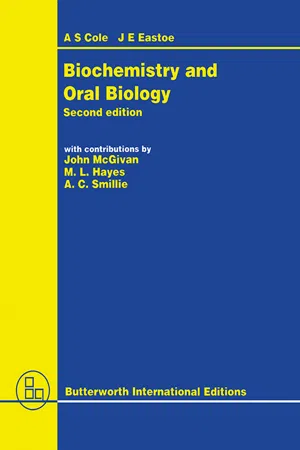
- 570 pages
- English
- ePUB (mobile friendly)
- Available on iOS & Android
Biochemistry and Oral Biology
About this book
Biochemistry and Oral Biology presents a unique exposition of biochemistry suitable for dental students. It discusses the structural basis of metabolism and the general principles of nutrition. It addresses the soft tissues, hard tissues, and the biology of the mouth. Some of the topics covered in the book are the free radical production; scope of biochemistry; characteristics of atoms; structure and properties of water; molecular building materials; ionization of proteins; affinity chromatography of proteins; structural organization of globular proteins; classification of enzymes; and biochemically important sugar derivatives. The naturally occurring fatty acids are fully covered. The nucleic acid components are discussed in detail. The text describes in depth the energy equivalents of different nutrients. The physiological effects of dietary fiber vitamin D deficiency are completely presented. A chapter is devoted to the alternative methods of fluoride administration and description of vitamins. The book can provide useful information to dental students, and researchers.
Frequently asked questions
- Essential is ideal for learners and professionals who enjoy exploring a wide range of subjects. Access the Essential Library with 800,000+ trusted titles and best-sellers across business, personal growth, and the humanities. Includes unlimited reading time and Standard Read Aloud voice.
- Complete: Perfect for advanced learners and researchers needing full, unrestricted access. Unlock 1.4M+ books across hundreds of subjects, including academic and specialized titles. The Complete Plan also includes advanced features like Premium Read Aloud and Research Assistant.
Please note we cannot support devices running on iOS 13 and Android 7 or earlier. Learn more about using the app.
Information
Introduction
Publisher Summary
The scope of biochemistry
Table of contents
- Cover image
- Title page
- Table of Contents
- Inside Front Cover
- Copyright
- Foreword
- Preface to the second edition
- Preface to the first edition
- Units
- Section 1: Some preliminary considerations
- Section 2: Molecular architecture – the building materials
- Section 3: Nutrition – sources of energy and materials
- Section 4: Molecular organization and interactions
- Section 5: Control processes
- Section 6: Soft tissues
- Section 7: Calcified tissues
- Section 8: Biology of the mouth
- Suggestions for further reading
- Index